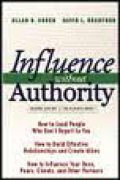My Account
Subscriptions
Summary Categories
Summary Collections
- Career & Life Satisfaction Collection
- Disruptive Innovation Collection
- Exceptional Leadership Collection
- Great Employees Only Collection
- Hidden Gems Collection
- Marketing Collection
- Must-Read Books for 2012 v1
- Must-Read Books for 2012 v2
- Must-Read Books for 2013
- Self-Help Collection
- Small Business Collection
- Strategic Assessment Collection
- Strategic Genius Collection
- Take Charge Collection
- Team Management Collection
- Ultimate Sales Collection
- Web Marketing Collection
Summary List
Influence Without Authority:How to Lead People Who Don't Report to You - How to Build Effective Relationships and Create Allies - How to Influence Your Boss, Peers, Clients, and Other Partners
Allan R. Cohen and David L. Bradford
Summarized May 2005
Type: [SUMMARY]
SKU: 5051
ISBN: 0471463302
Price: $12.50
Available Formats:




Purchase Summary
Summary Description
Whether someone is above you or below you in the corporate hierarchy, you often need to motivate them to get work done. Even if you're the top person, just ordering someone to do something won't necessarily work, as any CEO with a vision for major change can attest.
Whatever your job, you are expected to join your colleagues in doing important work, which will lead you to influence and be influenced. You will need to know how to sell important projects, persuade colleagues to provide the resources you need, create satisfactory working relationships with them and their managers, insist that your boss respond to issues that may not seem important to him or her, and in turn, respond to requests that associates make of you.
You can learn how to be more effective by developing true influence over the people with whom you work. In this summary, we will explore the following topics:
- First, we will outline the core influence model, including identifying your allies, clarifying your goals, and finding the trade-offs that can help you reach those goals.
- Second, we will take you through each of the stages of the influence model, from learning what you have that's worth trading, to what potential allies value for trading purposes, to building effective relationships, and making mutually profitable trades. And
- Third, we’ll examine how you can apply the influence model to familiar situations. We’ll discuss how you can influence your boss, difficult subordinates, and groups.
 Member Log In
Member Log In